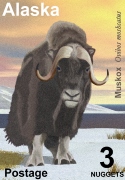An icy moon orbits a frozen world. You can decide which is which.

An Icy Moon in Orbit Around a Frozen Planet
The mountains in the image above are merely a rendered 3D fractal. If you are not familiar with fractals they are never-ending patterns, infinitely complex patterns that are self-similar across different scales. In other words, as you enlarge a fractal you will see the same, or very similar pattern emerge repeatedly ad infinitum as you enlarge the original fractal. This is called expanding symmetry or evolving symmetry. You are already familiar with fractal patterns, the natural world is full of them. Take a tree, as a simple example. The pattern of the trunk and branches and secondary branches is repeated as you move to the scale of branches, secondary branches and twigs. Another example would be the tiny rivulets of rain or melting snow water running onto successively larger flows until they are a large river emptying into a sea. Physical laws dictate that flowing water moves in similar ways at all scales. The same thing is true for coastlines at any scale; similar patterns reappear over and over and over as you look at ever smaller scales. As a result it is practically impossible to actually measure the exact length of a coastline.
The math behind fractals is very complicated, and I don’t understand it anywhere well enough to explain it. Even the experts are not in complete agreement as to how they should be defines. Even Benoit Mandelbrot, who is generally credited with developing the modern idea of self-similarity, fractals, in nature, once characterized them as, “beautiful, damn hard, increasingly useful. That’s fractals.” If you want to impress people at a party with how smart you are repeat Mandelbrot’s 1982 definition: “A fractal is by definition a set for which the Hausdorff-Bescovitch dimension strictly exceeds the topological dimension.”
So, enough with the heavy-duty science. You can find much more about the science of fractals on the Internet. I generally think of fractals as coming in 2D and 3D varieties. I do some work with both types, examples of which have appeared on this blog. 2D fractals are generally backgrounds or some other element; with the 3D fractals often being the mountainous terrain generated by various software packages.
Abstract, 2D fractals can be generated by a computer calculating a simple equation over and over. Here are a few examples, all made with the Apophysis fractal generator:

Brainstorm

Gravitational Blueshift

Quantum Entanglement

Structural Iridescence
Then there are 3D fractals. I used a free software package called Mandelbulb to create the examples in this post.
This is a very simple one in which the 3D nature is evident:

Simple 3D Cube-Style Fractal
Of course, 3D fractals can be much more involved:

A Blue Hatch, A Red Atmosphere

Alien War Helmet
And one I like very much – a habitat on a rocky moon or asteroid. The fractal reminded me of the cartoon-like atmosphere of some of the stories by the great Polish science fiction writer Stanislaw Lem, author of Solaris, The Cyberiad, Tales of Pirx the Pilot, and many others. I added a few elements to complete the scene including a spaceship Pirx would have been proud to fly.

Stanislaw Lem Station
Science and art! Cool, eh? You can do this too.



















